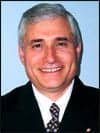Issue: 2007 International

|
| Yuri Sokolov |
Auditory evoked potential (AEP) tests are indispensable in the diagnostic test battery of today’s audiology field, particularly in pediatric practice and foremost in infant postscreening follow-up assessment. Auditory brainstem response (ABR) is the most widely used AEP; broadband click–evoked ABR is widely used for newborn hearing screening and differential diagnostics of cochlear versus retrocochlear pathology, such as auditory neuropathy/auditory dyssynchrony. Frequency-specific tone-burst ABRs are used to estimate hearing thresholds, particularly for further hearing aid fitting.1-3
Impediments in ABR Tests

|
| Figure 1. The Integrity™ system is a wireless diagnostic AEP and OAE analyzer that is designed to eliminate the need for sedation when doing ABR tests. |
While the most practically used, ABR is one of the smallest AEPs. Therefore, the much larger physiological artifacts and environmental noises interfere with the ABR—a problem known to every clinician doing ABR tests. Physiological artifacts originate from the patient’s body, primarily from muscular activity, and are present regardless of electromagnetic shielding. On the other hand, environmental noises come from the surrounding electric and magnetic fields and from power lines, and thus are independent of the patient’s muscular activity.
To minimize the effect of muscular artifacts, patients have to be relaxed; those who cannot relax, such as infants and young children, have to be sedated or anesthetized. Sedation or anesthesia for ABR is almost always required for infants and children from 3 months to 4 to 5 years of age.4 In some hospitals, this necessitates the use of an operating room—a very electromagnetically noisy environment. In other settings, sedation may be administered in an outpatient suite, but risks in such a suite might be higher. In either setting, sedation and anesthesia increase risk to the patient,5 testing costs, and the liability for the institution and examiner, effectively reducing clinical applicability of ABR and the level of patient care.

|
| Figure 2. Placement of the VivoLink™ on an infant. |
According to updated guidelines from the American Academy of Pediatrics and the American Academy of Pediatric Dentistry on sedation for therapeutic and diagnostic procedures,6 the associated risks of sedating pediatric patients include hypoventilation, apnea, airway obstruction, laryngospasm, and cardiopulmonary impairment. To mitigate those risks, the new guidelines particularly recommend patient evaluation for suitability, medical supervision of sedation, appropriately trained staff (trained in airway management in case of adverse response), special age- and size-appropriate equipment and supplies, sufficient staff to monitor the patient during and after the procedure, and a properly equipped and staffed recovery area.
Compliance with the guidelines requires a considerable amount of coordination and use of resources. Many parents are concerned about the risks and do not consent to sedating or anesthetizing their children for hearing tests, thus preventing the administration of the ABR test.
If nonsedated ABR results are unattainable, a child’s hearing function may not be properly assessed. Thus, children who cannot be sedated or anesthetized, in most cases, are not ABR tested, and miss timely diagnostics and hearing rehabilitation.
In addition to the need for sedation, electromagnetic interferences are a major concern for audiologists, forcing them to perform ABR tests in shielded rooms (Faraday cages), which are expensive, cumbersome, and unavailable in many settings, particularly neonatal intensive care units (NICU).
Eliminating Sedation in ABR Testing
Eliminating the need for sedation for ABR testing is of paramount importance, because without the need for sedation, many more patients become candidates for an EP test, such as patients of audiologists who do not have access to a sedation facility, patients with medical conditions counterindicating sedation, patients who require multiple ABR tests, and patients with sleep apnea (where sleep increases muscle artifacts and makes ABR results unattainable). Without sedation, ABR tests can be administered more often, for example, to monitor hearing status in infants and patients undergoing potentially ototoxic treatment. The Integrity™ system (Figure 1-2) is the world’s only wireless diagnostic AEP and OAE analyzer. It employs a combination of novel technologies that practically eliminate the need for sedation and anesthesia for ABR, as well as the use of Faraday cages.

|
| Figure 3. ABR results of 10-week-old premature infant in NICU. Click on image for larger version. |
The Amplitrode®, the only patented in-situ AEP amplifier, snaps directly onto the AEP electrode,7 and AEP signals are amplified where they appear on the skin surface. In-situ amplification dramatically reduces electric, magnetic, and radio frequency interferences, resulting in clearer signals that are then processed by the computer. Conducted noises, which come from AC power lines, are eliminated by wireless communications between the recording unit, the VivoLink™, and computer (ie, by removing the electrical path between the system and the power line).
Kalman filtering,8,9 a patented digital signal-processing technique, reduces the effects of muscular artifacts and eliminates the need for sedation or anesthesia. It does not reject any sweeps, no matter how contaminated it is by artifacts and noises, but extracts response information from every sweep—the less noise, the more information added to the recorded ABR trace.
In combination, these technologies produce clear responses in any patient and in any environment, as seen in Figure 3, which shows ABR results from a 10-week-old premature infant recorded in an NICU. Not only does the Integrity system enable clear responses, it also provides unprecedented freedom of mobility and convenience to the patient and clinician. Figure 4 illustrates the ease of use of the system in infants and toddlers.

|
| Figure 4. Color-coded release buttons allow easy snap-on and snap-off of the electrodes. |
Clinical Importance
Patients who were not candidates for sedation, and thus for conventional ABR, now have a means to be ABR-tested successfully. Children can be tested right where they are, even in the comforting arms of a parent or caregiver.
As James Hall III, PhD, of the University of Florida, Gainesville, put it in the Field Report of Gen Alexander Haig’s Health Journal Television program, “Vivosonic technology can have a major impact on the diagnostic assessment of hearing in infants and very young children. It has features that permit hearing testing in these children in a very natural environment without sedation and without anesthesia. This device has special software to process the brain activity from the child, which helps to eliminate all of the unwanted electrical activity coming from the electrodes and allows the equipment to detect more accurately the actual response from the baby’s brain.”10
Elevating the Level of Patient Care
Good ABR results are now attainable in nonsedated infants and young children, as well as in patients with sleep apnea, autism, cerebral palsy, and other conditions that clinicians know were previously difficult to test for ABR. A platform device with DPOAE, TEOAE, and EcochG, and extensibility to other tests, such as ASSR, Integrity is an indispensible tool for health care professionals: It makes AEP tests—and hence timely hearing assessment and treatment—available to all patients.
References
- Hall JW III. Handbook of Auditory-Evoked Responses. Boston: Allyn and Bacon; 1992.
- Hood L. Clinical Applications of the Auditory Brainstem Response. San Diego, London: Singular Publishing Group; 1998.
- Don M, Kwong B. Auditory brainstem response: different diagnosis. In: Katz J, ed. Handbook of Clinical Audiology. 5th ed. Philadelphia: Lippincott Williams & Wilkins; 2002:274-297.
- Hall JW III. New Handbook of Auditory Evoked Responses. Boston: Pearson Education; 2007.
- Krauss B, Green SM. Sedation and analgesia for procedures in children. N Engl J Med. 2000;342:938-945.
- American Academy of Pediatrics, American Academy of Pediatric Dentistry, Work Group on Sedation. Guidelines for monitoring and management of pediatric patients during and after sedation for diagnostic and therapeutic procedures. Pediatrics. 2006; 118:2587-2602.
- Kurtz I, Sokolov Y. A new method for the collection of AEPs. Hearing Review. 2004;11(3):64, 66.
- Li X, Sokolov Y, Kunov H, inventors. System and method for processing low signal-to-noise ratio signals. US patent 6,463,411. October 8, 2002.
- Li X, Sokolov Y, Kunov H, inventors. System and method for processing low signal-to-noise ratio signals. US patent 6,778,955. August 17, 2004.
- Effect of Vivosonic technology on diagnostic assessment of hearing in young children [transcript]. World Business Review’s Health Journal Television. Bravo. March 20, 2007. CNBC. March 21, 2007. www.healthjournaltv.com/media_stream/1823/vivosonic.html.
Yuri Sokolov, PhD; Isaac Kurtz, MHSc, PEng; Aaron Steinman, PhD, PEng; and Tanya Tomasino, BA, are affiliated with Vivosonic Inc. Correspondence can be addressed to Yuri Sokolov: .





